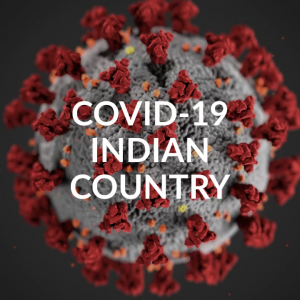 The Indian Health Service has updated its coronavirus data, showing results through January 26, 2022.
The Indian Health Service has updated its coronavirus data, showing results through January 26, 2022.
According to the data, 401,137 tests have returned positive for COVID-19, the disease caused by the coronavirus. That represents an increase of 3.9 percent from the 386,055 cases previously reported by the IHS on January 23.
The comparison, though, is based on cumulative tests. Going by the 7-day rolling positivity rates, the number of cases reported by the IHS has increased by 257 percent since Christmas and by 85 percent since the start of the new year.
Altogether, 3,926,289 coronavirus tests have been administered within the IHS, the results show. That represents an increase of 1.1 percent from three days prior.
Since mid-October of 2020, the IHS has been providing additional information about the spread of the coronavirus within the system. The cumulative percent positive column shows the historical COVID-19 infection rate, meaning the number of tests that have returned positive since the onset of the pandemic.
Based on the cumulative percent positive, the highest rates have been seen in five areas. Two of them include the state of Arizona, indicating a disproportionate toll of COVID-19 in the state:
- Navajo Area — 15.8 percent
- Oklahoma City Area — 15.4 percent
- Phoenix Area — 14.7 percent
- California Area — 10.9 percent
- Albuquerque Area — 10.5 percent
On January 19, the Oklahoma City Area overtook the Phoenix Area as the region with the second highest percentage of cumulative percent positive tests. The Oklahoma City Area is now approaching the top spot long held by the Navajo Area.
The 7-day rolling average positivity column offers a more contemporary look at the impact of the coronavirus. The data shows where COVID-19 cases have been increasing recently.
Based on the 7-day rolling average positivity, all 12 IHS areas are seeing high COVID-19 rates, continuing the post-Christmas holiday surge across every region of Indian Country.
- Tucson Area — 53.2 percent
- Oklahoma City Area — 43.2 percent
- Phoenix Area — 40.8 percent
- California Area — 36.5 percent
- Nashville Area — 35.6 percent
- Bemidji Area — 31.3 percent
- Navajo Area — 29.5 percent
- Billings Area — 27.6 percent
- Portland Area — 23.2 percent
- Albuquerque Area — 21.4 percent
- Alaska Area — 21.1 percent
- Great Plains Area — 17.5 percent
Overall, 10.9 percent of IHS tests have been positive since the onset of the pandemic, the data shows. Meanwhile, the 7-day positivity rate has dramatically jumped to a startling 32.5 percent following a short period of declining rates. High rates, yet still far below the current 7-day rate, were seen in Indian Country starting in the summer of 2021.
The data, however, is incomplete. While 100 percent of facilities run directly by the IHS are reporting data, only 33 percent of tribally managed facilities and 44 percent of urban Indian organizations are doing the same, the agency has told Indianz.Com.
Beginning June 7, 2021, the IHS began updating its coronavirus data on a weekly basis. But as the number of COVID-19 cases grows again, the agency is updating results on Mondays and Thursdays. During the height of the pandemic throughout 2020 and the first half of 2021, results were provided by the IHS every day.
COVID-19 Cases by IHS Area
Data are reported from IHS, tribal, and urban Indian organization facilities, though reporting by tribal and urban programs is voluntary. Data reflect cases reported to the IHS through 11:59 pm on January 26, 2022.
|
IHS Area
|
Tested
|
Positive
|
Negative
|
Cumulative
percent
positive
|
7-day rolling
average
positivity
|
|---|---|---|---|---|---|
| Alaska | 951,526 | 37,028 | 793,215 | 4.5% | 21.1% |
| Albuquerque | 135,186 | 12,003 | 102,142 | 10.5% | 21.4% |
| Bemidji | 273,768 | 25,583 | 247,177 | 9.4% | 31.3% |
| Billings | 143,145 | 11,509 | 127,853 | 8.3% | 27.6% |
| California | 150,928 | 15,734 | 128,477 | 10.9% | 36.5% |
| Great Plains | 222,744 | 22,047 | 199,763 | 9.9% | 17.5% |
| Nashville | 143,454 | 14,589 | 124,152 | 10.5% | 35.6% |
| Navajo | 431,940 | 58,049 | 309,775 | 15.8% | 29.5% |
| Oklahoma City | 940,015 | 142,567 | 784,598 | 15.4% | 43.2% |
| Phoenix | 271,457 | 39,663 | 230,318 | 14.7% | 40.8% |
| Portland | 200,530 | 16,156 | 183,792 | 8.1% | 23.2% |
| Tucson | 61,596 | 6,209 | 55,259 | 10.1% | 53.2% |
| TOTAL | 3,926,289 | 401,137 | 3,286,521 | 10.9% | 32.5% |
COVID-19 testing data is updated on Mondays and Thursdays by 5 pm ET.
Tuba City Regional Health Care Corporation (Navajo Nation)
HHS Small Ambulatory Program Awards $55 Million to 15 Tribes and Tribal Organizations (Indian Health Service)
Indian Health Service Announces New Deputy Director for Quality Health Care and Enterprise Risk Management (Indian Health Service)
Federal Emergency Management Agency (FEMA)
White House Office of Management and Budget (Joe Biden Administration)
Tuba City Regional Health Care Corporation (Arizona, Navajo Nation)
Oklahoma City Indian Clinic (OKCIC)
Indian Health Service (Department of Health and Human Services)
Navajo Nation Town Hall (Arizona, New Mexico, Utah)
Navajo Nation (Arizona, New Mexico, Utah)
Tribal organizations statement on advance appropriations for Indian Health Service
Indian Health Service Statement on Advance Appropriations (Department of Health and Human Services)
Indian Health Service (Department of Health and Human Services)
Indian Health Service (Department of Health and Human Services)
